
Concept explainers
- (a) (a.1)
Interpretation:
Number of signals expected in each of the following compounds in
Concept introduction:
The number of signals in
For each set of chemically equivalent protons, there will be one signal. For example, the
- (a) (a.1)
Answer to Problem 47P
Compound (1) will show 5 signals in its
Explanation of Solution
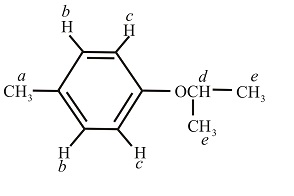
The set of chemically equivalent protons in a compound produces a separate signal in
(a.2)
Interpretation:
Number of signals expected in each of the following compounds in
Concept introduction:
The number of signals in
For each set of chemically equivalent protons, there will be one signal. For example, the
(a.2)
Answer to Problem 47P
Compound (2) will show 5 signals in its
Explanation of Solution
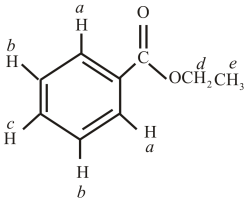
The set of chemically equivalent protons in a compound produces a separate signal in
(a.3)
Interpretation:
Number of signals expected in each of the following compounds in
Concept introduction:
The number of signals in
For each set of chemically equivalent protons, there will be one signal. For example, the
(a.3)
Answer to Problem 47P
Compound (3) will show 4 signals in its
Explanation of Solution
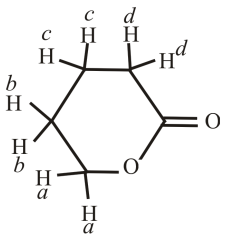
The set of chemically equivalent protons in a compound produces a separate signal in
(a.4)
Interpretation:
Number of signals expected in each of the following compounds in
Concept introduction:
The number of signals in
For each set of chemically equivalent protons, there will be one signal. For example, the
(a.4)
Answer to Problem 47P
Compound (4) will show 2 signals in its
Explanation of Solution
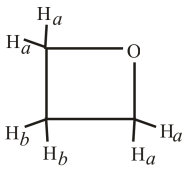
The set of chemically equivalent protons in a compound produces a separate signal in
(a.5)
Interpretation:
Number of signals expected in each of the following compounds in
Concept introduction:
The number of signals in
For each set of chemically equivalent protons, there will be one signal. For example, the
(a.5)
Answer to Problem 47P
Compound (5) will show 3 signals in its
Explanation of Solution
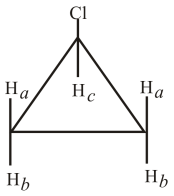
The set of chemically equivalent protons in a compound produces a separate signal in
(a.6)
Interpretation:
Number of signals expected in each of the following compounds in
Concept introduction:
The number of signals in
For each set of chemically equivalent protons, there will be one signal. For example, the
(a.6)
Answer to Problem 47P
Compound (6) will show 3 signals in its
Explanation of Solution
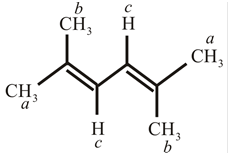
The set of chemically equivalent protons in a compound produces a separate signal in
- (b) (b.1)
Interpretation:
Number of signals expected in each of the following compounds in
Concept introduction:
The signals in the spectrum of a compound are proportional to the number of carbons that are present in the different environment within the molecule. The carbon which is present in the electron-rich environment shows a signal at a lower frequency and vice-versa. Therefore, the carbons that are present nearest to the electron-withdrawing groups produce a high-frequency signal.
- (b) (b.1)
Answer to Problem 47P
Compound (1) will show 7 signals in its
Explanation of Solution
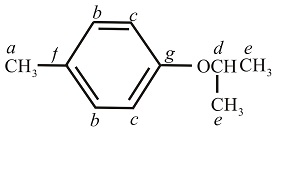
The set of chemically equivalent carbon in a compound produces a separate signal in
(b.2)
Interpretation:
Number of signals expected in each of the following compounds in
Concept introduction:
The signals in the spectrum of a compound are proportional to the number of carbons that are present in the different environment within the molecule. The carbon which is present in the electron-rich environment shows a signal at a lower frequency and vice-versa. Therefore, the carbons that are present nearest to the electron-withdrawing groups produce a high-frequency signal.
(b.2)
Answer to Problem 47P
Compound (2) will show 7 signals in its
Explanation of Solution
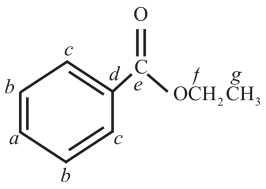
The set of chemically equivalent carbon in a compound produces a separate signal in
(b.3)
Interpretation:
Number of signals expected in each of the following compounds in
Concept introduction:
The signals in the spectrum of a compound are proportional to the number of carbons that are present in the different environment within the molecule. The carbon which is present in the electron-rich environment shows a signal at a lower frequency and vice-versa. Therefore, the carbons that are present nearest to the electron-withdrawing groups produce a high-frequency signal.
(b.3)
Answer to Problem 47P
Compound (3) will show 5 signals in its
Explanation of Solution
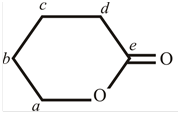
The set of chemically equivalent carbon in a compound produces a separate signal in
(b.4)
Interpretation:
Number of signals expected in each of the following compounds in
Concept introduction:
The signals in the spectrum of a compound are proportional to the number of carbons that are present in the different environment within the molecule. The carbon which is present in the electron-rich environment shows a signal at a lower frequency and vice-versa. Therefore, the carbons that are present nearest to the electron-withdrawing groups produce a high-frequency signal.
(b.4)
Answer to Problem 47P
Compound (4) will show 2 signals in its
Explanation of Solution
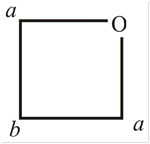
The set of chemically equivalent carbon in a compound produces a separate signal in
(b.5)
Interpretation:
Number of signals expected in each of the following compounds in
Concept introduction:
The signals in the spectrum of a compound are proportional to the number of carbons that are present in the different environment within the molecule. The carbon which is present in the electron-rich environment shows a signal at a lower frequency and vice-versa. Therefore, the carbons that are present nearest to the electron-withdrawing groups produce a high-frequency signal.
(b.5)
Answer to Problem 47P
Compound (5) will show 2 signals in its
Explanation of Solution
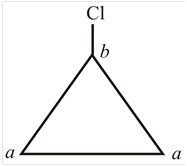
The set of chemically equivalent carbon in a compound produces a separate signal in
(b.6)
Interpretation:
Number of signals expected in each of the following compounds in
Concept introduction:
The signals in the spectrum of a compound are proportional to the number of carbons that are present in the different environment within the molecule. The carbon which is present in the electron-rich environment shows a signal at a lower frequency and vice-versa. Therefore, the carbons that are present nearest to the electron-withdrawing groups produce a high-frequency signal.
(b.6)
Answer to Problem 47P
Compound (6) will show 4 signals in its
Explanation of Solution
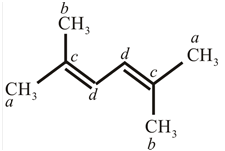
The set of chemically equivalent carbon in a compound produces a separate signal in
Want to see more full solutions like this?
Chapter 14 Solutions
Organic Chemistry, Books a la Carte Edition (8th Edition)
- Synthesize 2-Ethyl-3-methyloxirane from dimethyl(propyl)sulfonium iodide using the necessary organic or inorganic reagents. Draw the structures of the compounds.arrow_forwardSynthesize 2-Hydroxy-2-phenylacetonitrile from phenylmethanol using the necessary organic or inorganic reagents. Draw the structures of the compounds.arrow_forwardSynthesize N-Methylcyclohexylamine from cyclohexanol using the necessary organic or inorganic reagents. Draw the structures of the compounds.arrow_forward
- Synthesize N-Methylcyclohexylamine from cyclohexanol using the necessary organic or inorganic reagents. Draw the structures of the compounds.arrow_forwardIf possible, please provide the formula of the compound 3,3-dimethylbut-2-enal.arrow_forwardSynthesize 1,4-dibromobenzene from acetanilide (N-phenylacetamide) using the necessary organic or inorganic reagents. Draw the structures of the compounds.arrow_forward
- Indicate the products obtained by mixing (3-oxo-3-phenylpropyl)triphenylphosphonium bromide with sodium hydride.arrow_forwardWe mix N-ethyl-2-hexanamine with excess methyl iodide and followed by heating with aqueous Ag2O. Indicate the major products obtained.arrow_forwardIndicate the products obtained by mixing acetophenone with iodine and NaOH.arrow_forward
- Indicate the products obtained by mixing 2-Propanone and ethyllithium and performing a subsequent acid hydrolysis.arrow_forwardIndicate the products obtained if (E)-2-butenal and 3-oxo-butanenitrile are mixed with sodium ethoxide in ethanol.arrow_forwardQuestion 3 (4 points), Draw a full arrow-pushing mechanism for the following reaction Please draw all structures clearly. Note that this intramolecular cyclization is analogous to the mechanism for halohydrin formation. COH Br + HBr Brarrow_forward
 Organic ChemistryChemistryISBN:9781305580350Author:William H. Brown, Brent L. Iverson, Eric Anslyn, Christopher S. FootePublisher:Cengage Learning
Organic ChemistryChemistryISBN:9781305580350Author:William H. Brown, Brent L. Iverson, Eric Anslyn, Christopher S. FootePublisher:Cengage Learning

